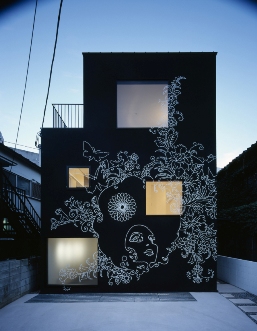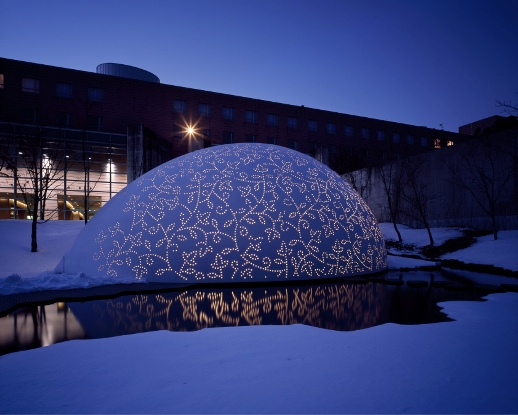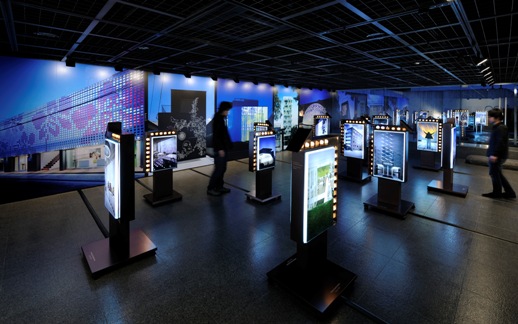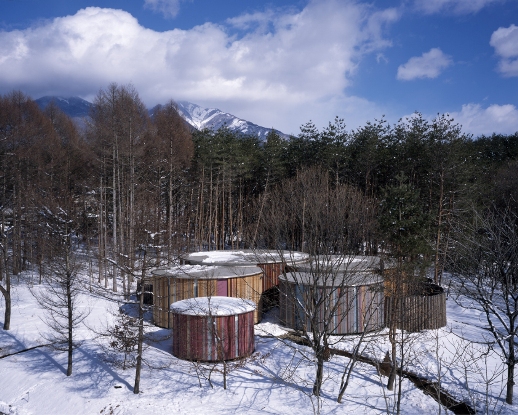Metropolitan Metamorphosis
Co-founders of SuperDeluxe and initiators of Pecha Kucha, the dynamic duo of Astrid Klein and Mark Dytham (KDa) likely need no introduction. The current show at Gallery Ma offers a chance to survey their recent works, and more broadly, an opportunity to reflect upon how architecture affects our perception of public space.
The exhibition includes a diverse assortment of KDa projects, the majority being commercial spaces: retail, offices, hotels, and several mixed-use buildings. The leisure projects — a reception space, an onsen, and a wedding chapel — are all for the Risonare resort in Yamanashi. The residential projects are mostly SoHo (small office/home office). Four other projects flirt with the realm of environmental art. These underscore a genre-bending quality in KDa’s work, also reflected in their design for the IT firm KAYAC, with its raised tatami floors, hori-kotatsu meeting space, and long continuous wood counters that resemble an izakaya interior as much as that of an office space.
Similarly, the design for ad agency Tbwa \ HAKUHODO is located in a reclaimed Tokyo bowling alley, where the rhythm of the open beams guides the arrangement of offices into the form of bowling lanes. In this project and others, we find a sensitivity to the features of the site, as well as a powerful desire to play with them. The latter is manifest as an against-the-grain spirit that affirms the vibrant chaos that is Tokyo itself. “In Europe,” Klein has remarked in an interview, “you have to respect architectural history, but in Tokyo there is no context left to respect.”

Rather than using paint to neutralize and unify an architectural surface, supergraphics work to over-code it. Thus, in the ‘Billboard Building’, we find a high-contrast bamboo grove on a sliver of land in the heart of Minato-ku, or a wall-sized Koji Morimoto anime character attending our departure from the Narita ‘Virgin Clubhouse’. In the ‘Leaf Chapel’, supergraphics are used to pattern the glass benches of the interior. The ceiling shell is patterned with a pergola motif, each of whose 4700 points incorporate a tiny acrylic lens to admit light from outside, casting a lace pattern over the fabric within. In a theatrical flourish, the chapel’s front wall opens like a motorized eye, just as the bride closes hers for the matrimonial kiss.

The dematerialization of form into surface assumes even greater significance in the project for Uniqlo Ginza. Here, the notion of a building as billboard is supplanted by that of the facade as an electronic screen, transforming an entire building into an advertisement. KDa envisions a walk though Ginza like strolling through the pages of a glossy magazine.
In addition to ceiling-high images of KDa projects affixed to its walls, the Gallery Ma is filled with freestanding electric signs [sutando kanban], the sort that adorn the entrances of shops, bars, and restaurants. Within the particular density of urban Japan, the sutando kanban has evolved into a design subgenre of its own, ranging from the garish scrolling-LED models that shout for attention on a bustling shotengai, to the more refined variety flanking the gate of a high-end establishment.

Conspicuously, KDa has chosen the type of kanban that we might encounter in front of a key duplication shop, each bearing photographs of a design project affixed to its fluorescent panels. In this manner, the images are presented as literal advertisements for KDa’s projects. These images, plan and section diagrams, as well as essays and interviews are all included in “—Ful”, the compact 316-page illustrated book, published by Toto Shuppan on the occasion of this exhibition.
The playfulness of KDa’s work has been frequently noted, as has their canny ability to transcend mere frivolity. In his essay “The Power of Making Jokes Stylish” [Share wo oshare ni suru chikara] (included in the exhibition book), architect Kaori Suehiro notes KDa’s interest in wordplay and puns [dajare], in reworking onomatopoeic words into trendy-sounding project titles like ‘Pika Pika Pretzel’ and ‘Moku Moku Yu’. Suehiro argues that the design approach pioneered by KDa could eventually change the character of public space in Japan. While these works certainly expand our perception of architectural style, a broader refunctioning of public space in Tokyo awaits a larger-scale confrontation with issues of policy and planning.

M. Downing Roberts
M. Downing Roberts



